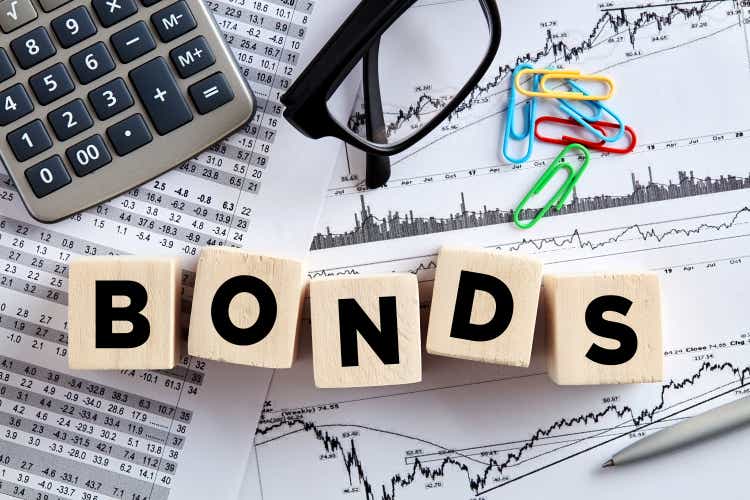[ad_1]
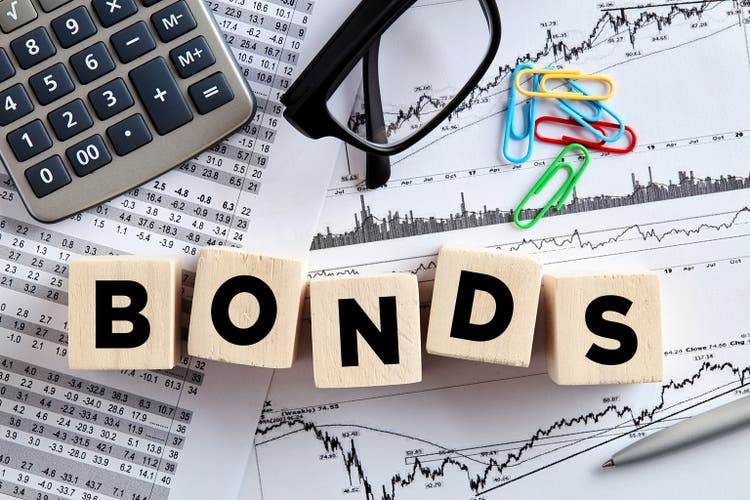
cagkansayin/iStock via Getty Images
The SPDR Portfolio High Yield Bond ETF (NYSEARCA:SPHY) is a simple high yield corporate bond index ETF. The fund offers investors a strong 5.8% yield, moderate dividend growth from recent interest rate hikes, some potential capital gains once bond matures and bond prices recover, and is quite cheap, with a 0.10% expense ratio. SPHY is a buy, and particularly appropriate for income investors and retirees.
SPHY – Basics
- Investment Manager: BlackRock
- Underlying Index: ICE BofA US High Yield Index
- Expense Ratio: 0.10%
- Dividend Yield: 5.75%
- Total Returns (Inception): 4.34%
SPHY – Overview
SPHY is a simple high yield corporate bond index ETF. The fund tracks the ICE BofA US High Yield Index, an index of these same securities. Said index includes all dollar-denominated bonds with non-investment grade credit ratings, subject to a basic set of liquidity, size, and maturity criteria. It is a simple, broad-based index, and a decent benchmark of the U.S. high yield corporate bond market.
SPHY itself is an incredibly well-diversified fund, with investments in over 2000 securities, and exposure to all relevant industry segments. Concentration is quite low too, with the fund’s top ten holdings accounting for less than 3.0% of the value of the fund. Diversification reduces portfolio risk and volatility, a benefit for the fund and its shareholders.
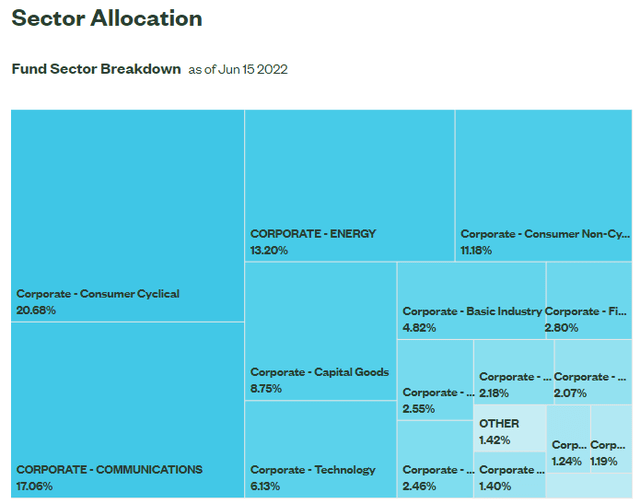
SPHY Corporate Website
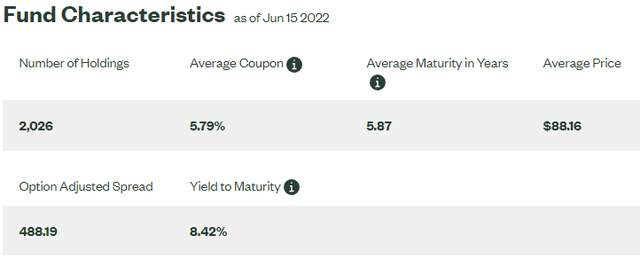
SPHY Corporate Website
SPHY’s holdings are almost all non-investment grade corporate bonds, issued by companies with weak balance sheets and financials, and with low credit ratings. Risks are higher than average for a bond fund, but still lower than most equity index funds. Expect sizable losses during downturns and recessions, somewhere between these two asset classes. This was the case during 1Q2020, the onset of the coronavirus pandemic, as expected.
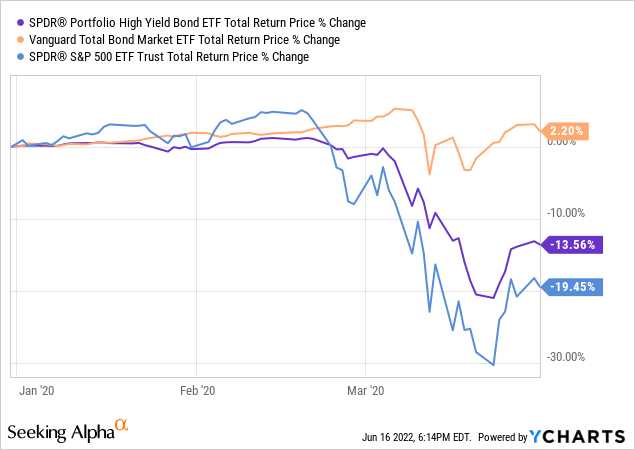
SPHY’s interest rate risk is below-average, with the fund sporting a duration of 4.1 years, lowest in its peer group.
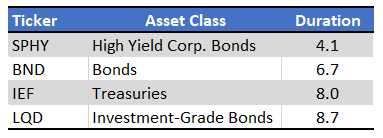
Fund Filings – Chart by author
Expect moderate losses if interest rates increase, but these should be lower than average. That has not been the case YTD, as rising interest rates have coincided with worsening economic fundamentals, lowering investor demand for comparatively risky assets like high-yield corporate bonds. Still, losses would have almost certainly have been higher if not for SPHY’s comparatively low duration, so said characteristic was something of a benefit for the fund and its shareholders these past few months.
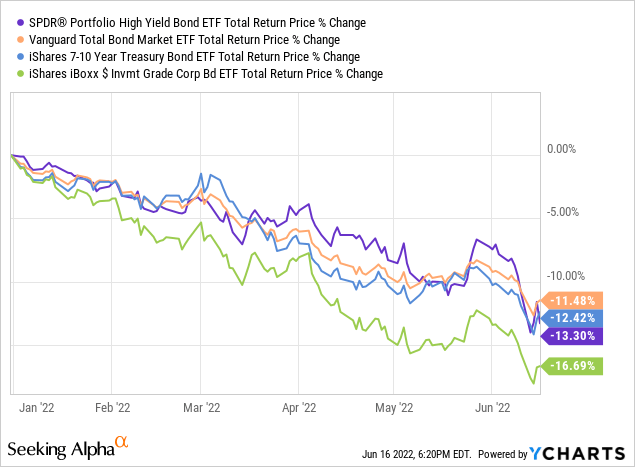
Besides the above, nothing much else stands out about SPHY’s index, holdings, or strategy. It is a simple high yield corporate bond index ETF, and its holdings and characteristics reflect that. With this in mind, let’s have a look at the fund’s investment thesis.
SPHY – Investment Thesis
Strong Dividend Yield
SPHY focuses on high yield corporate bonds which, as implied by their name, have comparatively high yields. These result in significant income for the fund, and significant dividends for shareholders. SPHY itself has a trailing twelve months yield of 5.8%, a reasonably good amount, and quite a bit higher than average for a bond fund.
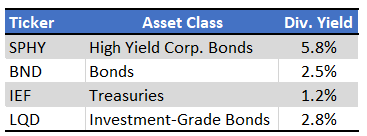
SeekingAlpha – Chart by author
SPHY’s yield is also somewhat higher than average for a high yield corporate bond ETF. It is, however, a tiny bit lower than the iShares Broad USD High Yield Corporate Bond ETF (USHY), which carries a 5.7% yield. USHY is incredibly similar to SPHY, and another fantastic high yield corporate bond ETF.
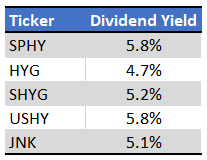
SeekingAlpha – Chart by author
SPHY’s above-average 5.8% dividend yield is a benefit for the fund and its shareholders, and SPHY’s core investment thesis. The fund is an income vehicle, which you buy for the yield.
Moderate Dividend Growth
Rising inflation has led to rising interest rates, with the Federal Reserve hiking rates these past two months. Officials and analysts are expecting further hikes all year long, with the market pricing in a 2.8% funds rate by year-end. Higher interest rates lead to higher coupon rate payments for newly-issued bonds which, boosting SPHY’s income, and ultimately resulting in higher dividends for shareholders.
As per SPHY’s management team, the fund’s underlying holdings currently sport a weighted average yield to maturity of 8.4%, quite a bit higher than the fund’s trailing twelve months yield of 5.8%. The vast majority of ETFs distribute any and all income generated to shareholders as dividends, and SPHY is no exception. As such, investors should expect the fund’s dividend yield to grow to 8.4%, an important benefit for shareholders.
SPHY’s dividend has seen some growth YTD, more or less as expected, but ETF dividends are somewhat volatile, so growth could perhaps simply be the result of said volatility. Time will tell if the fund’s dividends see significant, sustainable growth, but I do believe that this will be the case.
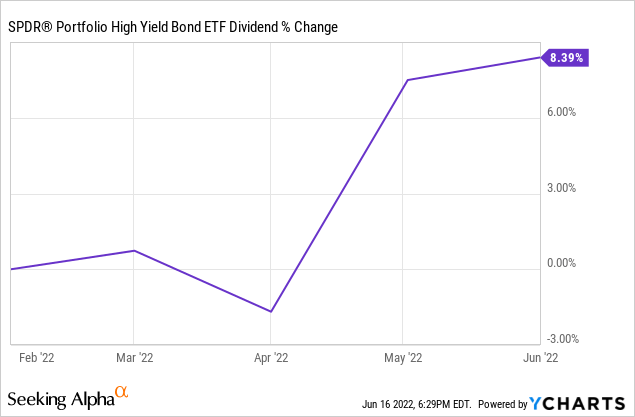
Potential Capital Gains
Higher interest rates, worsening economic fundamentals, and bearish investor sentiment have led to a sustained bond selloff, with most bonds and bond funds suffering significant losses YTD. SPHY’s share price has gone down by 15.2% YTD, a reasonably large amount.
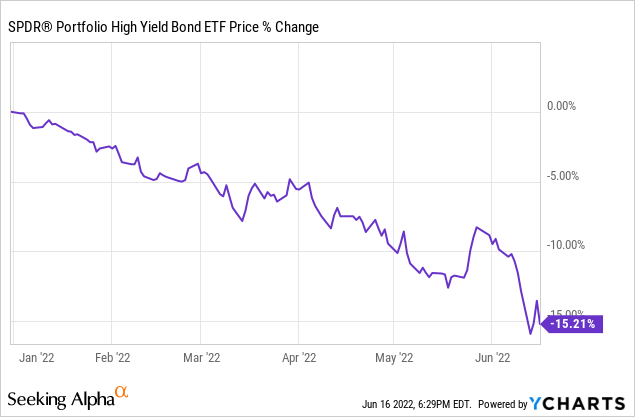
Importantly, only bond prices have gone down, investors are still owed their entire original investment back, recent losses notwithstanding. Meaning, investors will recover most of the losses above once bonds are repaid, as bonds are always repaid in full at maturity. By my calculations, SPHY’s bonds will recover around 12% of their losses at maturity, a reasonably good amount. SPHY’s bonds have an average maturity of around 6 years, so capital gains of around 2% per year from maturing bonds seem to be expected. Although these are comparatively small expected capital gains, gains are gains, and investors benefit from these regardless.
As a final note, we can add a fund’s underlying dividend yield and expected capital gains to arrive at an estimate of future total shareholder returns. Said metric is usually referred to as yield to maturity, or yield to worst. For SPHY, that would be 7.8%, or 5.8% + 2.0%. SPHY’s managers calculate said metric themselves, and arrive at a figure of 8.4% for the same, somewhat higher than my own due to expected/realized dividend growth (SPHY’s dividends have growth quite a bit YTD, and dividend yields have yet to fully account for these higher dividends).
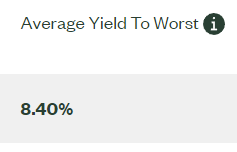
SPHY Corporate Website
SPHY’s yield to maturity is highest amongst its peer group, so the fund has the highest expected shareholders returns in the same, a benefit for the fund and its shareholders. The differences are quite small, however.
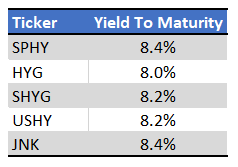
Fund Filings – Chart by Author
Low Expense Ratio
SPHY sports a 0.10% expense ratio, a relatively low amount, and lowest in its peer groups. Lower expenses always benefit shareholders, and are one of the only surefire ways to boost returns. Dividends can always be cut, capital gains can fail to materialize, but lower expenses always directly increase (reduce by less) returns. A strong actively-managed fund might generate sufficient alpha to overcome a high expense ratio, but that is almost never the case for a simple, diversified index fund. As such, I generally gravitate towards cheaper funds when looking at index funds, and SPHY is no exception.
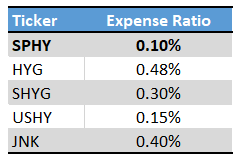
SeekingAlpha – Chart by author
Conclusion – Buy
SPHY’s above-average 5.8% yield, moderate potential dividend growth and capital gains, and low expense ratio, make the fund a buy.
[ad_2]
Source links Google News

